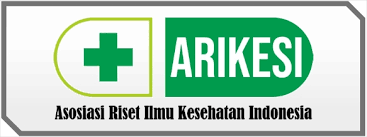Effect of Spirulina Platensis on Liver Malondialdehyde Levels of Male White Rat Induced by High Dose Paracetamol
Abstract
Paracetamol is widely used in therapy, yet it becomes hepatotoxic agent in a high dose using. The CYP450 enzyme metabolizes a small portion of paracetamol to a reactive substance, NAPQI. High dose of paracetamol causes an extensive increase in NAPQI levels. NAPQI then binds to hepatocytes conditions of oxidative stress. Spirulina platensis contains C-phycocyanin, flavonoids, and phenolics that inhibit lipid peroxidation and reduce oxidative stress. This study aims to determine the effect of Spirulina platensis on MDA levels in the liver tissue of male Wistar rats induced by high dose of paracetamol. This research was experimental with a Randomized Post-test Only Control Group design using 24 white male rats divided into three groups; negative control group (G-), positive control group (G+) was given paracetamol at a dose of 1,250 mg/kg on the 8th day, and treatment group (Gt) was given an amount of Spirulina platensis extract 360 mg/kg BW/day for ten days from 1st until 10th day and paracetamol at a single dose of 1,250 mg/kg BW on the 8th. At the 10th day of the treatment, all groups were terminated for liver tissue collection. TBA test was used to calculate MDA levels. Statistical tests analyzed the results of the data. This statistical tests by SPSS software: MDA levels in the treatment group did not significantly differ (p = 0.144) compared to the negative control group. There was a significant difference of liver tissue MDA levels in the treatment group (p = 0.016) compared to the positive control group. Â This study concludes that administering Spirulina platensis at a dose of 360 mg/kg/day for ten days can help prevent on increase in tissue MDA levels and maintain liver conditions close to their original state.
Keywords
Full Text:
PDFReferences
Ahmad, A., Manjrekar, P., Yadav, C., Agarwal, A., Srikantiah, R. M., & Hegde, A. (2016). Evaluation of ischemia-modified albumin, malondialdehyde, and advanced oxidative protein products as markers of vascular injury in diabetic nephropathy. Biomarker Insights, 11, 63–68. https://doi.org/10.4137/BMI.S39053
Ahmed, K. A., Korany, R. M. S., El Halawany, H. A., & Ahmed, K. S. (2019). Spirulina platensis alleviates arsenic-induced toxicity in male rats: Biochemical, histopathological and immunohistochemical studies. Advances in Animal and Veterinary Sciences, 7(8), 701–710. https://doi.org/10.17582/journal.aavs/2019/7.8.701.710
Alrahmany, R. (2012). Antioxidant and antimicrobial activities of phenolic acids rich extracts released from oat bran with the aid of carbohydrases. Thesis. Food Science and Nutrition. Carleton University, Ontario.
Anggraini, W., Rousdy, D. W., Wardoyo, E. R. P. (2021). Nilai
Malondialdehid Hepar Mencit yang diinduksi Parasetamol pada Pemberian Ekstrak Metanol Kulit Kayu Vitex pubescens Vahl,. Protobiont,10(1), 6-11
Baylan, M., Devrim Özcan, B., Işik, O., & Akar, M. (2012). A Mini Review on Spirulina. Türk Bilimsel Derlemeler Dergisi, 5(1), 31–34. www.nobel.gen.tr
Belay, A., Berestov, V., Bertolin, T. E., Pilatti, D., Cristina, A., Varrone, V., Bavaresco, C. S., Colla, L. M., Alberto, J., Costa, V., Chu, W. L., Lim, Y. W., Radhakrishnan, A. K., Lim, P. E., Falquet, J., Herrero, M., Ibanez, E., Senorans, F. J., Cifuentes, A., … Ibrahim, Z. K. (2008). Factors Affecting Oocyte Quality: Who is Driving the Follicle? Reproduction in Domestic Animals, 5(3), 809–822.
Ben-Shachar, R., Chen, Y., Luo, S., Hartman, C., Reed, M., & Nijhout, H. F. (2012). The biochemistry of acetaminophen hepatotoxicity and rescue: A mathematical model. Theoretical Biology and Medical Modelling, 9(1). https://doi.org/10.1186/1742-4682-9-55
Burhan, H. W., Mewo, Y. M., & Assa, Y. A. (2021). Efek Antioksidan dari C-Fikosianin pada Spirulina. 9(1). https://doi.org/10.35790/ebm.9.1.2021.31908
Chellappan, D. K., Ganasen, S., Batumalai, S., Candasamy, M., Krishnappa, P., Dua, K., Chellian, J., & Gupta, G. (2016). The Protective Action of the Aqueous Extract of Auricularia polytricha in Paracetamol Induced Hepatotoxicity in Rats. In Recent Patents on Drug Delivery & Formulation, 10(1), 72-6. doi: 10.2174/1872211309666151030110015. PMID: 26517821.
de Andrade, K. Q., Moura, F. A., dos Santos, J. M., de Araújo, O. R. P., Santos, J. C. de F., & Goulart, M. O. F. (2015). Oxidative stress and inflammation in hepatic diseases: Therapeutic possibilities of N-acetylcysteine. International Journal of Molecular Sciences, 16(12), 30269–30308. https://doi.org/10.3390/ijms161226225
Engli, K. A. (2012). Defisiensi Glukosa-6-fosfat dehidrogenase (G6PD). Tugas Biokimia Kedokteran. Universitas Brawijaya
Enzing C, Ploeg M, Barbosa M, Sijtsma L, authors Vigani M, Parisi C, Rodriguez Cerezo E, editors. (2014). Microalgae-based products for the food and feed sector: an outlook for Europe. EUR 26255. Luxembourg (Luxembourg): Publications Office of the European Union. https://doi.org/10.2791/3339
Esperanza, Y., Prabowo, S., & Handajani, F. (2021). Pengaruh Pemberian Curcumin Terhadap Perbaikan Fungsi Hepar Tikus Putih (Rattus Novergicus) yang diinduksi Parasetamol Dosis Tinggi. Jurnal Ilmiah Kedokteran Wijaya Kusuma, 10(2), 208. https://doi.org/10.30742/jikw.v10i2.1250
Fernandes, R., Campos, J., Serra, M., Fidalgo, J., Almeida, H., Casas, A., Toubarro, D., & Barros, A. I. R. N. A. (2023). Exploring the Benefits of Phycocyanin: From Spirulina Cultivation to Its Widespread Applications. Pharmaceuticals, 16(4). https://doi.org/10.3390/ph16040592
Frank, J. E. (2005). Diagnosis and management of G6P deficiency. American Family Physician, 72(7), 1277–82. Retrieved from http://www.ncbi.nlm.nih.gov/pubmed/16225031D
Ghneim, H. K., & Alshebly, M. M. (2016). Biochemical markers of oxidative stress in Saudi women with recurrent miscarriage. Journal of Korean Medical Science, 31(1), 98–105. https://doi.org/10.3346/jkms.2016.31.1.98
Güroy, B., Karadal, O., Mantoğlu, S., & Irmak Cebeci, O. (2017). Effects of different drying methods on C-phycocyanin content of Spirulina platensis powder. Ege Journal of Fisheries and Aquatic Sciences, 34(2), 129–132. https://doi.org/10.12714/egejfas.2017.34.2.02
Hall, J. E. (John E. (2016). Guyton and Hall textbook of medical physiology (13th ed.).
Hidayati, H., & Kustriyani, A. (2020). Paracetamol, Migraine, and Medication Overuse Headache (Moh). JPHV (Journal of Pain, Vertigo and Headache), 1(2), 42–47. https://doi.org/10.21776/ub.jphv.2020.001.02.5
Novirianthy, R., & Sekarutami, S. M. (2015). Pengaruh Kadar Malondialdehid dan Aktivitas Antioksidan Katalase terhadap Toksisitas Akut Radiasi pada Kanker Serviks Stadium Lanjut Lokal. Radioterapi & Onkologi Indonesia, 6(2): 81-92
Rahmawati, N., Sugiyanta, & Sakinah, E. N. (2018). Pengaruh Pemberian Cuka Apel “A†terhadap Kadar MDA Hepar Tikus Wistar Jantan yang Diinduksi Parasetamol Dosis Toksik. Pustaka Kesehatan, 6(2), 272-277. https://doi.org/10.19184/pk.v6i2.7667
Ridlo, A., Sedjati, S., Supriyantini, E. (2016). Aktivitas Anti Oksidan Fikosianin Dari Spirulina Sp. Menggunakan Metode Transfer Elektron Dengan DPPH (1,1-difenil-2-pikrilhidrazil). Jurnal Kelautan Tropis, 18(2), 58–63. DOI: https://doi.org/10.14710/jkt.v18i2.515
Riza, M. M., & Devi, N. A. (2015). Kandungan Total Fenol Dan Aktivitas Antioksidan Ekstrak Air Daun Kersen (Muntingia calabura L.) Total Content of Fenol and Antioxidant Activity of The Aqueous Extract of Cherry Leaf (Muntingia calabura L.). Jurnal Kedokteran Yarsi, 23(3).
Sayed, A. A., Soliman, A. M., Taha, M. A., & Sadek, S. A. (2022). Spirulina and C-phycocyanin mitigate titanium dioxide nanoparticle-induced hematobiochemical and hepatorenal disorders through antioxidative pathway. Food Chemistry Advances, 1(January), 100035. https://doi.org/10.1016/j.focha.2022.100035
Singh, Z., Karthigesu, I. P., Singh, P., & Kaur, R. (2014). Use of Malondialdehyde as a Biomarker for Assessing Oxidative Stress in Different Disease Pathologies: a Review. In Iranian J Publ Health, 43(3). http://ijph.tums.ac.ir
Sukmaningbayu, A. J., Sudjarwo, S. A., & Setiabudi, R. S. (2016). Efek Terapeutik Ekstrak Spirulina platensis pada Gambaran Histopatologi Kerusakan Hati Tikus (Rattus norvegicus) yang diinduksi Ethanol. Veterina Medika, 9(3): 23-30.
Verma, P. K., Raina, R., Sultana, M., Prawez, S., & Jamwal, N. (2013). Hepatoprotective mechanisms of Ageratum conyzoides L. on oxidative damage induced by acetaminophen in Wistar rats. Free Radicals and Antioxidants, 3(2), 73–76. https://doi.org/10.1016/j.fra.2013.05.009
Warshaw, J. B., Wilson, C. W., Saito, K., & Prough, R. A. (1985). The responses of glutathione and antioxidant enzymes to hyperoxia in developing lung. Pediatric Research, 19(8), 819–823. https://doi.org/10.1203/00006450-198508000-00008
Yuniati, R., Zainuri, M., & Kusumaningrum, H. (2020). Qualitative Tests of Secondary Metabolite Compounds in Ethanol Extract of Spirulina platensis from Karimun Jawa Sea. Indonesia. Biosaintifika: Journal of Biology & Biology Education, 12(3), 343–349. http://dx.doi.org/10.15294/biosaintifika.v12i3.23153
Yuniastuti, A. (2016). Dasar Molekul Glutation dan Perannya sebagai Antioksidan , Buku Monograft. Semarang: FMIPA Press.
Zulaikhah, S. T. (2017). The Role of Antioxidant to Prevent Free Radicals in The Body. Sains Medika : Jurnal Kedokteran Dan Kesehatan, 8(1), 39. https://doi.org/10.30659/sainsmed.v8i1.1012
DOI: http://dx.doi.org/10.30742/jikw.v12i2.2700
Refbacks
- There are currently no refbacks.
Copyright (c) 2023 Sihning Tehupuring

This work is licensed under a Creative Commons Attribution-NonCommercial 4.0 International License.
Jurnal Ilmiah Kedokteran Wijaya Kusuma is licensed under a Creative Commons Attribution-NonCommercial 4.0 International License

Â









